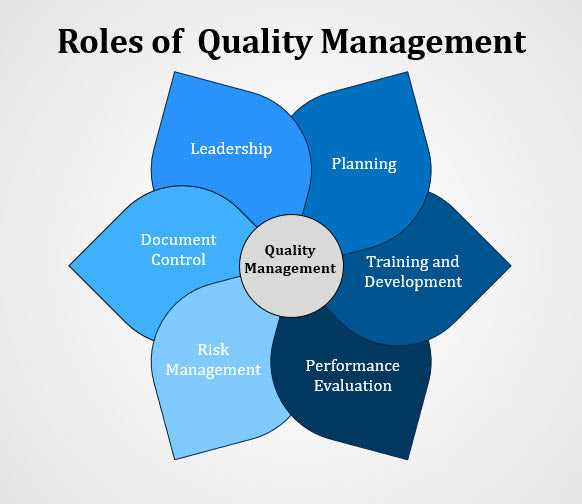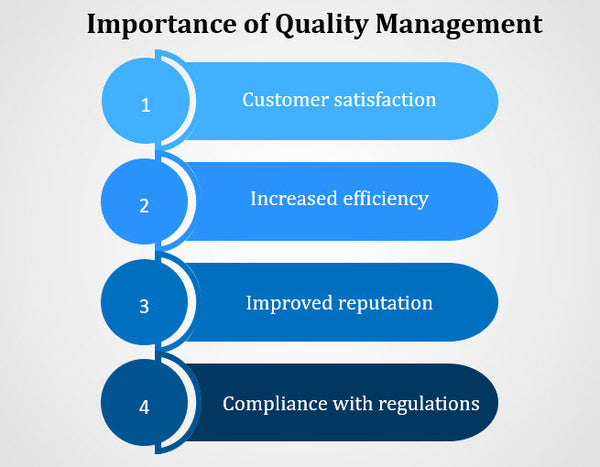The Roles & Responsibilities of Quality Management
Overview
Quality management is a crucial aspect of any organization, as it strives to ensure that the products or services delivered to customers meet their requirements and expectations. A quality management system (QMS) provides a framework for achieving this goal by establishing procedures, processes, and responsibilities to achieve quality objectives.

What is Quality Management?
Quality Management is the process of ensuring that a product or service meets or exceeds the expectations and requirements of customers. It involves establishing and maintaining quality standards for all aspects of a business, including products, services, processes, and people.
The goal of Quality Management is to continually improve the quality of a product or service through steps such as quality planning, quality control, quality assurance, and continuous improvement. It is essential for companies to have a strong quality management system in place to compete effectively in the marketplace and achieve long-term success.
Roles of a Quality Management :
- Leadership: Top management must clearly define and communicate the organization's quality policy, objectives, and expectations. They are also responsible for providing adequate resources for the implementation and maintenance of the QMS.
- Planning: This involves determining the objectives and processes needed to deliver results in accordance with the organization's quality policy and strategic direction.
- Document Control: The QMS should have comprehensive documentation, which is controlled to ensure that it is current, accurate, and accessible to authorized personnel.
- Risk Management: This involves identifying, analyzing and mitigating risks and opportunities that may impact the performance of the QMS or the organization's ability to achieve its objectives.
- Performance Evaluation: The performance of the QMS should be regularly evaluated against established quality objectives and performance metrics. This feedback should be used to improve the system and support decision-making.
- Training and Development: The QMS should ensure that personnel are competent, trained, and aware of their roles and responsibilities within the organization.
Responsibilities of Quality Management
- Implementing quality policies: Quality Management is responsible for formulating and implementing quality policies that will ensure that the organization produces high-quality products and services.
- Developing quality standards: Quality Management must develop quality standards that will guide the organization in producing products and services that meet the customer's requirements.
- Ensuring regulatory compliance: Quality Management must ensure that the organization maintains compliance with all the regulations applicable to its industry.
- Establishing quality control procedures: Quality Management must establish quality control procedures that will help detect and address quality issues before they can cause bigger problems.
- Monitoring quality performance: Quality Management must monitor the quality performance of the organization continuously, identify areas needing improvement, and implement corrective actions.

Importance of Quality Management in an Organization
- Customer satisfaction: Quality management helps in meeting customer expectations by ensuring the products and services are of high quality. Customer satisfaction is essential as it leads to customer loyalty and repeat business.
- Increased efficiency: Quality management ensures that the processes are streamlined, and waste is reduced. This helps in improving efficiency, reducing costs, and increasing profits.
- Improved reputation: Quality management creates a positive reputation for the organization. If customers are satisfied with the products and services, they will spread positive word-of-mouth, leading to increased sales and a good reputation in the market.
- Compliance with regulations: Quality management helps organizations comply with regulatory requirements and standards. This ensures that the products and services meet legal requirements and are safe for customers.
Maintaining a Quality Management System
- Review and update the QMS: Continuously review and update the QMS to ensure it remains relevant and effective. Evaluate the system at regular intervals to identify areas for improvement, such as performance gaps and operational inefficiencies.
- Conduct internal audits: Regular internal audits help identify potential lapses in the quality management system and enable businesses to adjust promptly before issues arise. Consultants or independent auditors can help facilitate internal auditing.
- Training: Provide adequate training for employees, especially new employees, about the company's quality objectives, policies, and procedures. Proper training ensures that employees are equipped enough to follow all the quality standards and safety guidelines.
- Monitor key performance indicators (KPIs): Identify key performance indicators that evaluate the effectiveness of the QMS and monitor these indicators regularly. These KPIs should be aligned with the mission and objectives of the company.
Challenges Faced By Quality Management
- Resistance to change: Implementing quality management systems requires significant changes in procedures, processes, and behaviors, which can meet resistance from employees, particularly those who have been working in an organization for a long time.
- Lack of training: Without proper training of employees, there may be difficulties in implementing quality management systems.
- Inadequate resources: Organizations with limited resources may find it challenging to invest in quality management systems due to the cost involved.
- Complex processes: Quality management systems can be complex, especially for larger organizations. The complexity can lead to confusion and difficulties in implementing and maintaining the system.
- Communication issues: Effective communication is essential for the implementation of quality management systems. Communication breakdowns can lead to errors, misinterpretations, and misunderstandings that can cause problems.
Conclusion
In conclusion, quality management is an essential aspect of any organization to ensure customer satisfaction, employee morale, and business growth. However, the implementation of quality management faces several challenges such as resistance to change, inadequate resources, lack of employee participation, and difficulties in measuring and assessing quality objectives.
With these efforts, organizations can build a robust quality management system that ensures their products and services meet or exceed customer expectations and maintain a competitive edge in the market.




